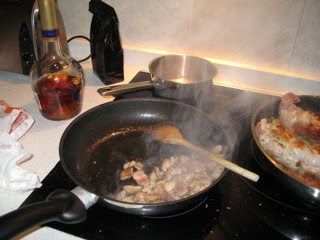I've been reading Jacque Pepin's Complete Techniques book, which is a combination of two of his previous works from the 70s and I was sitting at the office and I decided to browse online at some of his recipes on Food & Wine's website. Found a recipe for a cassoulet from his short cuts cookbook which caught my attention with the current frigid weather, something hot, filling, and with plenty of cerdo. I printed out the recipe and headed out to the butcher in town. I wasn't able to find the sausages called for in the recipe so I went with a combination of 6 chicken sausages and some delicious pork sausage, and of course pancetta. Bought 2 bottles of alubias at the supermarket, and some cebolletas, and I was set. This is more of an adaptation of the recipe than a direct recreation, due to the fact that the ingredients called for were hard to get a hold of like kielbasa (good luck finding that type of sausage in a market of a small town outside Granada). So I started by pouring the oil and a little water in a pan and adding the sausages once heated.

While that was cooking I sliced and diced some onion, garlic, and the cebolleta I bought. I had bought some zucchini the other day and thought I could put it to some good use in this dish, so that got diced as well. Added the veggies and let that all cook for about 5 minutes and then added the "alubias" with their juice which I wasn't too sure about, as I don't like to add liquids from bottles or cans but I went with the recipe's direction. Added some squirts of tabasco, I like things spicy so I went with about 10-15 "dashes." I saw that it was thickening up a bit, so I added about 1/2 cup of some carrot stock I had left over.

Let it reduce a little. Preheated the oven to 220 degrees celsius, and found a clay dish. I had baked some potatoes for lunch and had some leftover. I cut them in half and placed them on the bottom of the dish. Took out the sausages from the pan, and cut them up into more bite-size portions.

Poured the beans, diced pancetta, and veggies into the potato-lined dish and then topped with sausages and some knife-diced baquette crumbs and placed it into the oven.



The "cassoulet" was very good, but I would love to attempt an authentic and very very traditional version to see what its supposed to taste and look like, canned beans turn a little mushy after very little cooking. However, I did like that it didn't taste greasy, which I have noticed a lot in the "pocheros" and "ollas" served in Andalucia and why I hated the "callos" served at Tapaç 24 (I went to Bar Pinotxo at Mercado Boqueria earlier in the day where my friend, Rodrigo from
Por mis Fogones, ordered the callos and they were delicious). While I was in Barcelona, I had decided that I was going to try either Inopia or Tapaç 24, it started raining and Tapaç was closer. I had the patatas bravas and the cap i trips (callos) and I found that sticky unappetizing taste of greasy fat in the callos at T. The patatas bravas were really overwhelmed by an aioli that tasted like sunflower oil, and thats about it. It's bad when I have better aioli in Granada than a well reviewed and popular tapas bar in Barcelona. I don't understand how making your mouth covered in a greasy broth can be appetizing, I feel like I have motor oil stuck to the roof of my mouth, so I think the chicken sausages helped cut down on that, but again I would really like to experiment with a traditional recipe and compare.



























